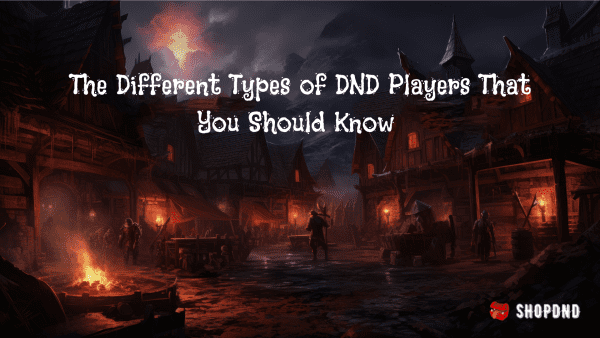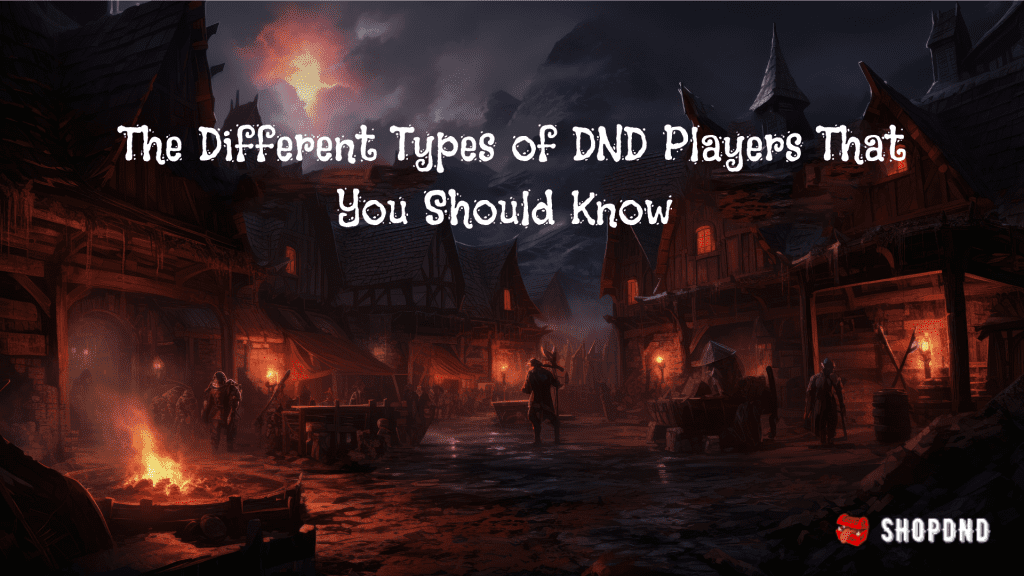
The Different Types of DND Players That You Should Know
In the exciting world of Dungeons & Dragons, your imagination can run wild and the adventures are limitless! One of the keys to this great role-playing game is understanding the different types of dnd players around the table.
With countless hours playing Dungeons and Dragons under our belts here at Shop DND, we’ve learned that everyone has their unique style and personality which they bring to the game. As a Dungeon Master, knowing these different styles and types of players can make your game sessions more enjoyable and engaging for everyone. So, are you ready to learn the many different types of DND players? Read on to learn more!
Our 8 Different Types DND Players
1. The Storyteller
We’ll start our list of the different types of DND players with The Storyteller. The Storyteller thrives on the narrative fabric of D&D, weaving rich personal backstories into the game's overarching plot. This player relishes a well-told story and enjoys games where their narrative choices significantly affect the outcome.
In engaging Storytellers, DMs should offer complex story arcs that challenge their characters morally and ethically. Introduce multifaceted NPCs, intertwining quests, and moral dilemmas that require deep thought and personal decision-making.
Storytellers are often at their best when they can express their character’s perspective and influence the storyline. Encourage them by recognising the depth they bring to the session and by actively incorporating elements from their character’s background into the main campaign. This recognition not only heightens their involvement and investment in the game, but also deepens everyone's immersion in the world you've created together.
2. The Strategist (formerly The Tactician)
The Strategist is a player who excels at planning and execution within the D&D universe. They are cerebral players who delight in analysing and overcoming complex challenges through careful thought and strategic foresight.
These players are particularly engaged during battles where they can deploy their well-thought-out plans and tactics, and during puzzles that require a methodical approach. To captivate Strategists, DM’s must incorporate intricate battle scenarios that necessitate advanced planning and the clever use of resources. Provide them with opportunities to scout, prepare and control the battlefield, in the process often turning combat into a chess game that rewards strategic thinking. Lastly, if you’re a DM looking to put together some puzzles worthy of the Strategist at your table, then Dicebreaker have some guidance for you…
Additionally, challenge them with puzzles and campaigns that involve political intrigue or military strategy, where their decisions have lasting consequences on the game world. Enthuse them further by highlighting the effectiveness of their strategies in shaping the campaign’s direction, giving them a sense of accomplishment and influence over the game’s narrative.
3. The Socialiser
The Socialiser is the lifeblood of the D&D party. They thrive on the interactions between characters and the shared storytelling experience. They bring a vibrant dynamic to the game too, often facilitating communication and bonding among players.
This type of player enjoys sessions where role-playing and team interactions are abundant, and they delight in forging alliances and navigating the social intricacies of the game world.
To engage Socialisers, DM’s must create rich and interactive environments filled with compelling NPCs and intricate networks of relationships. Events like bustling town festivals, courtly intrigues, or diplomatic negotiations can give them the perfect stage to shine.
Enhance their experience by giving them room to lead some discussions, make pivotal decisions that affect group dynamics, and solve conflicts through dialogue rather than combat. By recognising and praising their role in keeping the group cohesive and entertained, you can keep them deeply engaged and eager to contribute to every session.
4. The Power Gamer
The Power Gamer is driven by a desire to optimise and maximise their character, often delving deep into the mechanics of D&D to build the most effective and formidable characters possible. These players revel in the thrill of combat and the strategic elements of character development, and they are always seeking ways to enhance their prowess through skills, spells, and powerful gear.
To fully engage Power Gamers, provide challenging combat scenarios that test their tactical skills and character builds. You should offer rewards that align with their goals, such as rare artifacts and unique weapons that complement their playing style. Incorporate complex enemies and intricate combat situations that require them to think critically and apply their optimised abilities.
To get them to invest in a campaign even more, highlight their achievements and milestones within the game, celebrating their successes in overcoming formidable foes and mastering difficult challenges. This recognition not only fuels their competitive spirit but also encourages them to push the limits of their character’s potential.
5. The Casual Gamer
The Casual Gamer enjoys Dungeons & Dragons for its social aspects and the fun, laid-back experiences it offers, rather than delving into the complexities of game mechanics or intense strategy. These players appreciate a game environment where the focus is on enjoying the journey rather than the outcome.
To keep Casual Gamers engaged and excited, incorporate light-hearted adventures with a focus on storytelling, humour, and simple joys of character interaction. They often thrive in sessions where the rules are flexible and the stakes are not too high, allowing them to experiment and enjoy the game without the pressure of intense competition or deep role-play.
DM’s can encourage the participation of a casual gamer by designing quests that require collaborative problem-solving and celebrate collective successes, making sure everyone feels included and valued. By emphasising the fun and communal nature of the game, you can create an inviting and enjoyable atmosphere that perfectly suits the Casual Gamer's play style.
6. The Actor
The Actor immerses themselves completely in their D&D character, embracing every facet of role-playing with enthusiasm and dedication. This type of player excels in embodying their character's traits, motivations, and background stories. They will often use distinct voices and mannerisms to bring their roles to life. They will also relish opportunities for in-depth character interaction and development - so they thrive in games that prioritise storytelling and emotional depth.
Creating rich and character-driven narratives that offer them ample space to explore their roles will engage them. You should also include complex personal quests and moral dilemmas that challenge their character’s ideals and provoke deep role-play. Additionally, encourage them to lead in-character interactions and reward their creative contributions with meaningful impacts on the game's storyline.
To further enhance their experience, acknowledge their performance and its impact on the overall campaign. In short, make sure to reinforce the value they bring to the gaming table. If you feel like you are an actor-type, or you’re DM’ing a game including actors, these tips from D&D Beyond may be useful to you too.
7. The Risk Takers
The Risk Takers in Dungeons & Dragons are the adventurers who thrive on uncertainty and excitement, often pushing the boundaries of the game with bold decisions and creative strategies. These players love the thrill of the unknown, and are motivated by scenarios that challenge the status quo and require them to think outside the box.
If you’re DM’ing a game including Risk Takers, you should try to design game elements that are unpredictable, and also incorporate high-stakes situations to test their decision-making under pressure. Introduce elements such as treacherous quests, uncharted territories, and morally ambiguous choices that compel them to take chances. Celebrate their daring moves and occasionally let their gambles lead to spectacular successes thus enhancing their impact on the game's narrative.
To bring even more to their experience, highlight the dramatic outcomes of their actions, whether successful or catastrophic, to underscore the thrilling unpredictability they bring to every session.
8. The Explorer
Rounding out our list of different types of DND players, we have The Explorer. The Explorer is captivated by the vastness and mystery of the Dungeons & Dragons universe. This player type is driven by curiosity and a desire to uncover every hidden corner and secret the game has to offer. They delight in maps, lore, and new locations, always pushing the boundaries of the known world.
Engaging explorers will require richly detailed worlds with layered histories, diverse cultures, and sprawling landscapes. Include hidden dungeons, forgotten lands, and mysterious artifacts that promise rewards and revelations. Encourage their sense of adventure by providing clues and puzzles that lead to undiscovered treasures or ancient truths.
To further enhance their experience, regularly introduce new environments and lore-heavy elements that fuel their thirst for discovery and keep them intrigued by the endless possibilities within the game world.
Summing up our Types of Players in DND
You should now have a basic grasp of the different types of players in DND. By recognising and understanding their differences between them, as a DM you should now be ready to create a fun, memorable and enjoyable experience for your group. Likewise as a player, maybe you’ve recognised which type of player you are, and know more about what’s likely to be enjoyable for you when looking for a new campaign.
Lastly though - don’t forget that our list of different types of DND players isn’t ‘absolute’ - players don’t have to fit neatly into any of the 8 ‘boxes’ we’ve laid out today. Some people may be a combination of two or more of the personas we’ve talked about here, they may have other qualities and styles not mentioned here - and that’s great because it keeps DM’s thinking and offers scope for each campaign you play to be different and unique.
If you enjoyed this article, be sure to check out our other blogs for more fun DND content - in particular you might enjoy this blog on Dungeons & Dragons rules, or this blog about the different character classes in DND.


